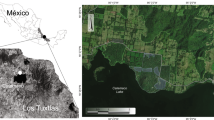Abstract
In 1989 a new gelada baboon (Theropithecus gelada) population was found in Arsi, on the opposite side of the Rift Valley to that of the known gelada populations of Semien and Showa. Previous comparisons of units of the band at Gado Goro, Arsi, in the same season in consecutive years, indicated that unit structure is less stable among Arsi geladas as compared to the Semien population. Gelada units of the band at Gado-Goro were studied for 7 months in order to investigate the processes of social changes. Changes in unit structure were observed. Provisioning was carried out for 1.5 months at the beginning of the 7-month study period, in order to capture and obtain blood samples from the geladas. Following this, changes in male leadership of some units were observed, presumably as a consequence of the capture. However, natural changes also occurred. One change in unit structure occurred after a female gave birth, and changes in another unit occurred after the disappearance of the leader male. These changes involved female desertion of a unit, her subsequent transfer to a male unit, and culminated in the formation of a unit consisting of one female and one male. One successful and one attempted case of unification of units, and one case of change of a unit leader male are reported. These changes occurred among eight resident units in a period of 7 months (196 female months). Though the types of social changes were not much different from previous observations in Semien National Park, their frequencies seemed to be much higher. The characteristics of Arsi gelada social changes are proposed to be related to the small size of the units. We also describe a new confirmed case and one suspected case of infanticide, as well as one case of abortion at the time of male leader change.


Similar content being viewed by others
References
Belay G, Shotake T (1998) Blood protein variation of a new population of gelada baboon (Theropithecus gelada), in the southern rift valley, Arusi Region, Ethiopia. Primates 39:183–198
Crook JH (1966) Gelada baboon herd structure and movement - a comparative report. Symp Zool Soc Lond 18:237–258
Dunbar RIM (1979) Structure of gelada baboon reproductive units. I. Stability of social relationships. Behaviour 69:72–87
Dunbar RIM (1984) Reproductive decisions: an economic analysis of gelada baboon social strategies. Princeton University Press, Princeton, N.J.
Dunbar RIM, Dunbar EP (1975) Social dynamics of gelada baboons, Karger, Basel, Switzerland
Kawai M (ed) (1979) Ecological and sociological studies of gelada baboons. Contributions to primatology, vol 16. Karger, Basel, Switzerland
Mori A, Belay G (1990) The distribution of baboon species and a new population of gelada baboons along the Wabi-Shebeli river, Ethiopia. Primates 31:495–508
Mori A, Iwamoto T, Bekele A (1997) A case of infanticide in a recently found gelada population in Arusi, Ethiopia. Primates 38:79–88
Mori A, Iwamoto T, Mori U, Bekele A (1999) Sociological and demographic characteristics of a recently found Arsi gelada population in Ethiopia, Primates 40:365–381
Mori U (1978) Social structure and dynamics in gelada baboons (Theropithecus gelada). Paper prepared in advance for participants in "Baboon Field Research: Myth and Models." June 25–July 4, 1978. Wenner-Gren Foundation for Anthropological Research, New York
Mori U (1979) Individual relationships within a unit. In: Kawai M (ed) Ecological and sociological studies of gelada baboons. Karger, Basel, Switzerland, pp 94–124
Mori U, Dunbar RIM (1985) Changes in reproductive condition of female gelada baboons following the takeover of one-male units. Z Tierpsychol 67:215–224
Ohsawa H (1979) Herd dynamics. In: Kawai M (ed) Ecological and sociological studies of gelada baboons. Karger, Basel, Switzerland, pp 47–80
Ohsawa H, Inoue M, Takenaka O (1993) Mating strategy and reproductive success of male patas monkeys (Erythrocebus patas). Primates 34:533–544
Sugiyama Y (1965) On the social change of hanuman langurs (Presbytis entellus) in natural conditions. Primates 6:381–417
Acknowledgements
We wish to thank the Department of Biology, Addis Ababa University for providing us with the opportunity to undertake this study. We thank also Dr. Seyoum Mengestou, Dr. Afework Bekele, Mr. Goitom Redda, and staff of the Biology Department of Addis Abeba University for their help in the arrangement and undertaking of this research as a joint project between Addis Ababa University and Kyoto University. We are indebted to Dr. T. Shotake for his help in conducting the research and his valuable discussions in preparing this manuscript. We thank Dr. Vanessa Hayes and Gordon M. Barrett for comments and English correction of the manuscript. The long-term field work was supported by grants under the Monbusho (=Japanese Ministry of Education, Science, and Culture) International Scientific Research Program (Nos. 04041084, 10041174 to T. Iwamoto, 06041065 to T. Shotake), and grant of the Overseas Special Research Program of the Primate Research Institute Kyoto University, 1995, from Monbusho, and Grant-in-Aid for COE Research (No. 10CE 2005).
Author information
Authors and Affiliations
Corresponding author
About this article
Cite this article
Mori, A., Belay, G. & Iwamoto, T. Changes in unit structures and infanticide observed in Arsi geladas. Primates 44, 217–223 (2003). https://doi.org/10.1007/s10329-002-0013-9
Received:
Accepted:
Published:
Issue Date:
DOI: https://doi.org/10.1007/s10329-002-0013-9




